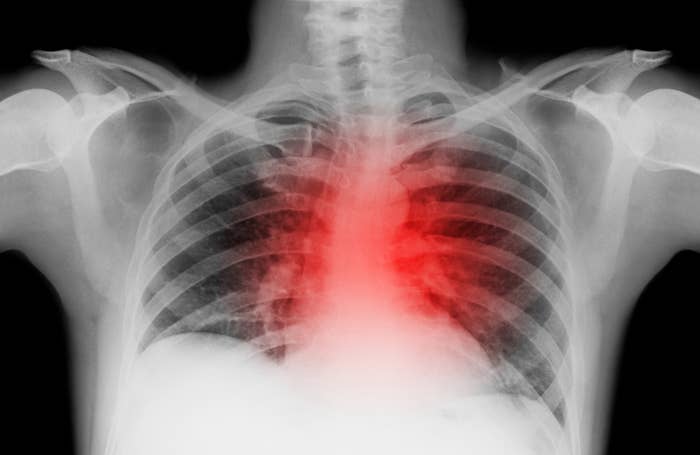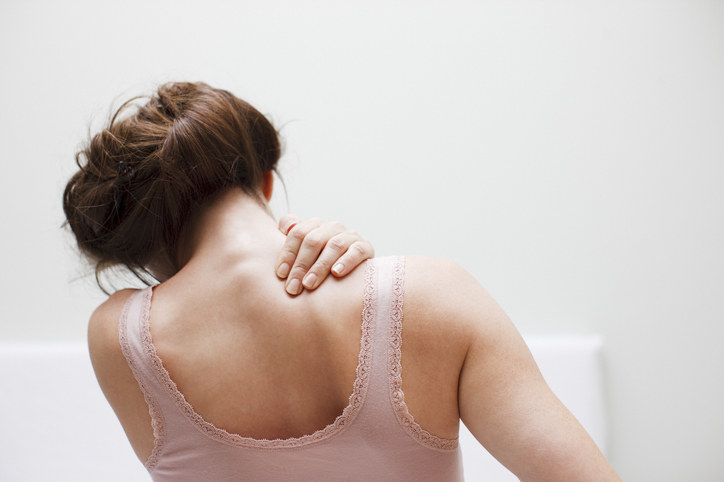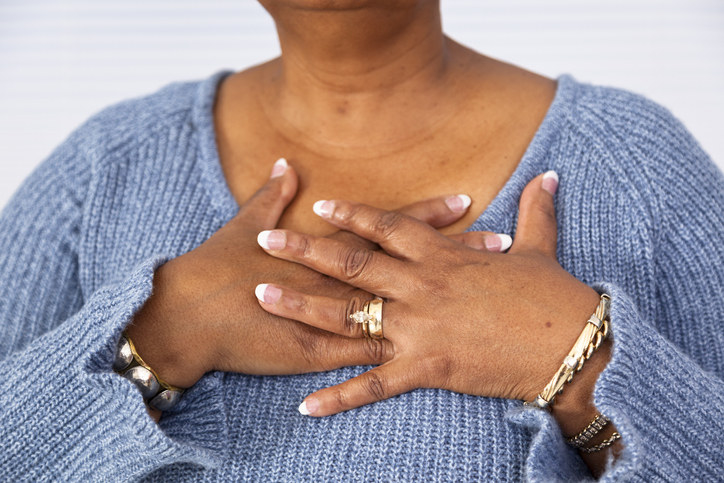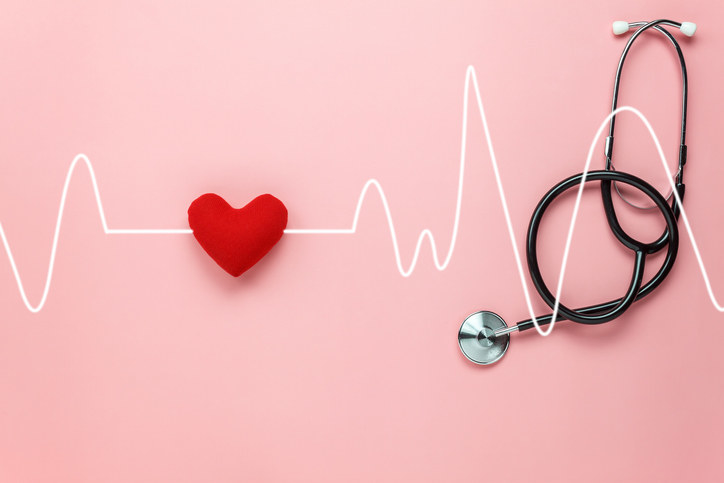Heart attack symptoms aren't always obvious, especially for women, and one survivor shared her story on Twitter to warn others.

In the movies, heart attacks are typically dramatic and sudden: A man grips his chest in pain and collapses. While chest pain is commonly associated with heart attacks, it isn't the only symptom. Heart attack symptoms may look different for everyone, especially women, and some signs are easier to miss than others.
A heart attack occurs when the blood that delivers oxygen to the heart muscle is reduced or cut off entirely. This can happen when the arteries that carry blood to the heart muscle become narrowed or blocked from a buildup of plaque, made up of cholesterol, fat, and other substances.
When the plaque breaks off or ruptures, a blood clot can form and block blood flow through the artery to the heart. When the heart is deprived of oxygen, part of it becomes damaged or dies. This is a heart attack.
One woman who recently survived a heart attack spread awareness on Twitter about the subtle and lesser-known heart attack symptoms that she almost missed entirely.
On Sunday, Twitter user @geewheezie posted a thread about her experience having a heart attack, and why she initially missed the symptoms. It has since gone viral.
I want to warn women our heart attacks feel different. Last Sunday I had a heart attack. I had a 95% block in my left anterior descending artery. I’m alive because I called 911. I never had chest pain. It wasn’t what you read in pamphlets. I had it off & on for weeks.
The tweet has been retweeted more than 37,000 times and received 73,000 likes so far. @Geewheezie told BuzzFeed News she did not want to be identified, but she wrote in the thread that she is an older woman and works as a nurse.
She wrote that she felt a "burning & aching" pain across her upper back, shoulder blades, and arms — but thought it was muscle strain.
The pain ran across my upper back, shoulder blades & equally down both arms. It felt like burning & aching. I actually thought it was muscle strain. It wasn’t until I broke into drenching sweat & started vomiting that I called 911.
"I had been spending the week helping my neighbor clean out her barn, I thought I strained some muscles. I took Motrin & put a warm pack on my shoulders," @geewheezie wrote in the thread.
"The day before my heart attack I drove 6 hours to help my mother who lives in another state. I thought I should go to a [doctor] but I had to help my mom who is 90 & I’d just tough it out because it wasn’t real bad," she continued.
"I almost died because I didn’t call it chest pain," she wrote in one tweet.
According to her tweets she was taken to a hospital that performs cardiac catheterizations, a procedure in which a long, thin, tube is threaded into a blood vessel leading to the heart. Doctors then inject dye to visualize the blood vessels and identify any problems or blockages.
"I had 4 stents placed an hour after I got to the ER," she wrote in another tweet. A stent is a tiny tube made of mesh wire that props the artery open so blood can flow freely. Stents can restore blood flow and reduce the chances that heart muscle will die during a heart attack.
According to an expert, the woman's experience is not uncommon, because women are more likely than men to experience subtle or "silent" symptoms — like back pain, nausea, or fatigue.

"It's traumatic, and it happens all the time... women are suffering with symptoms and they don't really know what's happening," Dr. Suzanne Steinbaum, director of women’s cardiovascular prevention, health and wellness at the Mount Sinai hospital in New York City, told BuzzFeed News.
"Men often get the crushing chest pain, but for women it can be much more subtle," Steinbaum points out. While women may certainly experience chest pain as well, many do not — and instead have symptoms like shortness of breath; pain in the jaw, shoulders, arms, or upper back; nausea; vomiting; or exhaustion. It may even feel like a bad flu, Steinbaum notes. These can come on suddenly or develop slowly or come and go for days or weeks, like they did for the author of the Twitter thread.
"One thing I tell women is that if they are doing an activity that's usually easy and all of the sudden it becomes very difficult, they should think of their heart," she said.
While men may also experience these subtle or atypical symptoms, they are more common in women. Why? "Our assumption is that the way plaque develops in women is a little different than in men and our assumption is that heart attacks are not usually as massive as they are in men, so symptoms are less pronounced," said Steinbaum, who is also a volunteer medical expert for the American Heart Association's program Go Red for Women.
As a result, some women may overlook symptoms and end up not getting timely, appropriate care.

"You just don’t think it's your heart," Steinbaum said. "Traditionally, many women don't think they’re at risk or that it’s a 'man’s disease' and it's not their problem." This trend can be seen outside the US as well.
According to a recent study from the European Society of Cardiology, women wait longer than men to get help when they experience heart attack symptoms largely due to the misconception that it's a problem affecting men. The researchers, who published their findings in the European Heart Journal, found that women wait approximately 37 minutes longer to seek medical help, and were less likely to attribute their symptoms to a condition that requires urgent medical attention.
And getting quick treatment is important. Restoring blood flow to the heart as fast as possible can reduce the chance that heart tissue will be damaged or die.
But it's not just women who miss heart attack symptoms, it's health care providers, too. Multiple studies have shown that women are not getting the same care as men, Steinbaum noted. So it's important for women to advocate for themselves when communicating with doctors.
"Women need to be aware of that and not only stand up for themselves when explaining their symptoms but also by saying 'I'm really worried it's my heart' — using those words becomes so important."
Women should be aware of the different heart attack symptoms and also the risk factors for heart disease, Steinbaum said.

If you experience any of the classic heart attack symptoms — pressure or pain in the chest, shortness of breath, arm pain, dizziness — or the subtle ones mentioned earlier, call 911 or seek medical care immediately. If you are not sure, it's still important to see a doctor and get checked out.
As long as you have a heart you can develop heart disease, which is the leading cause of heart attacks, Steinbaum noted. Heart disease is the number-one killer of women worldwide.
The more risk factors you have, the greater your chance of developing heart disease. These include things you can't change, such as age or a family history of heart disease.
Other risk factors are high blood pressure, high cholesterol, diabetes, obesity, a sedentary lifestyle, and stress, Steinbaum said. Unlike genetics, for example, these risk factors can be modified or controlled to help reduce your risk of heart disease. "Eighty percent of the time, heart disease is preventable based on how we live ... so we recommend everyone going to get checked and knowing their risk factors," Steinbaum said.
Click here for more information on heart attacks in women.
